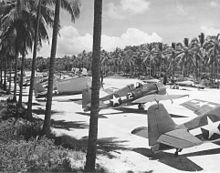History of Vanuatu
[7] Europeans did not return until 1768, when Louis Antoine de Bougainville visited the islands, naming them the Great Cyclades.
In 1825, trader Peter Dillon's discovery of sandalwood on the island of Erromango began a rush that ended in 1830 after a clash between immigrant Polynesian workers and indigenous Melanesians.
For example, John Geddie, a Scots-Canadian presbyterian missionary, arrived at the island of Aneityum in 1848; he spent the rest of his life there, working to convert the inhabitants to Christianity and western ways.
In 1878 Britain and France declared all of the New Hebrides to be neutral territory,[14] but the lack of a functional government led to rising discontent among British and French colonists.
On 9 August 1889, Franceville declared itself independent under the leadership of mayor/president Ferdinand Chevillard and with its own red, white and blue flag with five stars.
The Convention of 16 October 1887 established a joint naval commission for the sole purpose of protecting French and British citizens, but claimed no jurisdiction over internal native affairs.
Melanesians were barred from acquiring the citizenship of either power and were officially stateless; to travel abroad they needed an identity document signed by both the British and French resident commissioners.
[10] Many called the condominium the "Pandemonium" because of the duplication of laws, police forces, prisons, currencies, education and health systems.
In their book, Vanuatu by Jocelyn Harewood and Michelle Bennett, is this memorable passage referring to the 1920s: "Drunken plantation owners used to gamble... using the 'years of labour' of their Melanesian workers as currency.
Long after America's Wild West was tamed, Vila was the scene of the occasional gunfight and public guillotining."
The mass participation of Ni-Vanuatu men in the Labor Corps had a significant effect on the John Frum movement, giving it the characteristics of a cargo cult.
In the 1960s France opposed Britain's desire to de-colonize the New Hebrides, fearing that the independence sentiment would be contagious in their mineral-rich colonial possessions in French New Caledonia.
Philippe Allonneau, the French representative, even succeeded in being recognized as King of Espiritu Santo by the island's tribal chiefs.
Beginning in June 1980, Jimmy Stevens, head of the Nagriamel movement, led an uprising against the colonial officials and the plans for independence.
The rebels blockaded Santo-Pekoa International Airport, destroyed two bridges, and declared the independence of Espiritu Santo island as the "State of Vemerana".
[26] On 8 June 1980, the New Hebrides government asked Britain and France to send troops to put down a rebellion on the island of Espiritu Santo.
[27] France refused to allow the United Kingdom to deploy troops to defuse the crisis, and French soldiers stationed on Espiritu Santo took no action.
As independence day neared, the Prime Minister-elect, Walter Lini,[28] asked Papua New Guinea if it would send troops to intervene.






